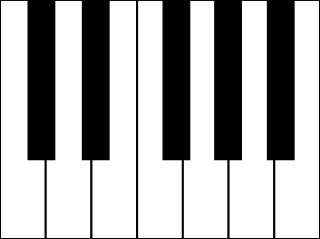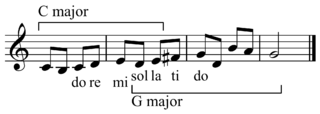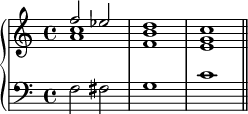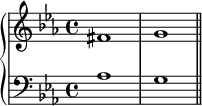
The major scale is one of the most commonly used musical scales, especially in Western music. It is one of the diatonic scales. Like many musical scales, it is made up of seven notes: the eighth duplicates the first at double its frequency so that it is called a higher octave of the same note.
In music, the tonic is the first scale degree of the diatonic scale and the tonal center or final resolution tone that is commonly used in the final cadence in tonal classical music, popular music, and traditional music. In the movable do solfège system, the tonic note is sung as do. More generally, the tonic is the note upon which all other notes of a piece are hierarchically referenced. Scales are named after their tonics: for instance, the tonic of the C major scale is the note C.

The chromatic scale is a set of twelve pitches used in tonal music, with notes separated by the interval of a semitone. Chromatic instruments, such as the piano, are made to produce the chromatic scale, while other instruments capable of continuously variable pitch, such as the trombone and violin, can also produce microtones, or notes between those available on a piano.
In music theory, a leading-tone is a note or pitch which resolves or "leads" to a note one semitone higher or lower, being a lower and upper leading-tone, respectively. Typically, the leading tone refers to the seventh scale degree of a major scale, a major seventh above the tonic. In the movable do solfège system, the leading-tone is sung as ti.
In music theory, the key of a piece is the group of pitches, or scale, that forms the basis of a musical composition in Western classical music, art music, and pop music.
Tonality or key: Music which uses the notes of a particular scale is said to be "in the key of" that scale or in the tonality of that scale.
An altered chord is a chord that replaces one or more notes from the diatonic scale with a neighboring pitch from the chromatic scale. By the broadest definition, any chord with a non-diatonic chord tone is an altered chord. The simplest example of altered chords is the use of borrowed chords, chords borrowed from the parallel key, and the most common is the use of secondary dominants. As Alfred Blatter explains, "An altered chord occurs when one of the standard, functional chords is given another quality by the modification of one or more components of the chord."

A chord, in music, is any harmonic set of pitches consisting of multiple notes that are sounded simultaneously, or nearly so. For many practical and theoretical purposes, arpeggios and other types of broken chords may also be considered as chords in the right musical context.

In music, modulation is the change from one tonality to another. This may or may not be accompanied by a change in key signature. Modulations articulate or create the structure or form of many pieces, as well as add interest. Treatment of a chord as the tonic for less than a phrase is considered tonicization.
Modulation is the essential part of the art. Without it there is little music, for a piece derives its true beauty not from the large number of fixed modes which it embraces but rather from the subtle fabric of its modulation.

In music theory, the circle of fifths is a way of organizing the 12 chromatic pitches as a sequence of perfect fifths.. If C is chosen as a starting point, the sequence is: C, G, D, A, E, B, F♯, C♯, A♭, E♭, B♭, F. Continuing the pattern from F returns the sequence to its starting point of C. This order places the most closely related key signatures adjacent to one another. It is usually illustrated in the form of a circle.

In music, relative keys are the major and minor scales that have the same key signatures, meaning that they share all the same notes but are arranged in a different order of whole steps and half steps. A pair of major and minor scales sharing the same key signature are said to be in a relative relationship. The relative minor of a particular major key, or the relative major of a minor key, is the key which has the same key signature but a different tonic.
In music theory, an augmented sixth chord contains the interval of an augmented sixth, usually above its bass tone. This chord has its origins in the Renaissance, was further developed in the Baroque, and became a distinctive part of the musical style of the Classical and Romantic periods.
In music, the submediant is the sixth degree of a diatonic scale. The submediant is named thus because it is halfway between the tonic and the subdominant or because its position below the tonic is symmetrical to that of the mediant above.
In music, the subtonic is the degree of a musical scale which is a whole step below the tonic note. In a major key, it is a lowered, or flattened, seventh scale degree. It appears as the seventh scale degree in the natural minor and descending melodic minor scales but not in the major scale. In major keys, the subtonic sometimes appears in borrowed chords. In the movable do solfège system, the subtonic note is sung as te.

In music, a closely related key is one sharing many common tones with an original key, as opposed to a distantly related key. In music harmony, there are six of them: four of them share all the pitches except one with a key with which it is being compared, one of them share all the pitches, and one shares the same tonic.

A heptatonic scale is a musical scale that has seven pitches, or tones, per octave. Examples include:

In music theory, the harmonic major scale is a musical scale found in some music from the common practice era and now used occasionally, most often in jazz. In George Russell's Lydian Chromatic Concept it is the fifth mode (V) of the Lydian Diminished scale. It corresponds to the Raga Sarasangi in Indian Carnatic music, or Raag Nat Bhairav in Hindustani music.
In music theory, the half-diminished seventh chord is a seventh chord composed of a root note, together with a minor third, a diminished fifth, and a minor seventh. For example, the half-diminished seventh chord built on B, commonly written as Bm7(♭5), or Bø7, has pitches B-D-F-A:

Diatonic and chromatic are terms in music theory that are most often used to characterize scales, and are also applied to musical instruments, intervals, chords, notes, musical styles, and kinds of harmony. They are very often used as a pair, especially when applied to contrasting features of the common practice music of the period 1600–1900.

In music, chromatic mediants are "altered mediant and submediant chords." A chromatic mediant relationship defined conservatively is a relationship between two sections and/or chords whose roots are related by a major third or minor third, and contain one common tone. For example, in the key of C major the diatonic mediant and submediant are E minor and A minor respectively. Their parallel majors are E major and A major. The mediants of the parallel minor of C major are E♭ major and A♭ major. Thus, by this conservative definition, C major has four chromatic mediants: E major, A major, E♭ major, and A♭ major.
In music, the dominant is the fifth scale degree of the diatonic scale. It is called the dominant because it is second in importance to the first scale degree, the tonic. In the movable do solfège system, the dominant note is sung as "So(l)".





![This phrase from Cesar Franck's Variations symphoniques (1885), mm. 5-9, demonstrates chromaticism from use of parallel keys (borrowed chords), that "chordal structures ... [may be] partially resultants of the descending bass lines" and that "chromatic evasiveness internally in the phrases [may be] countered by cadence strength and clarity", such as the "resolute movement from V of V to V to I". Cesar Franck Variations Symphoniques mm 5-9 excerpt with 'chromatic analysis'.png](http://upload.wikimedia.org/wikipedia/commons/thumb/b/b6/Cesar_Franck_Variations_Symphoniques_mm_5-9_excerpt_with_%27chromatic_analysis%27.png/300px-Cesar_Franck_Variations_Symphoniques_mm_5-9_excerpt_with_%27chromatic_analysis%27.png)
![Chromaticism from "linear considerations" [voice leading], borrowed chords, and extended chords from the ending of Alexander Scriabin's Preludes, Op. 48, No. 4; "though most vertical sonorities include the seventh, ninth, eleventh, and thirteenth, the basic harmonic progressions are strongly anchored to the concept of root movement by fifths". Alexander Scriabin Op. 48, No. 4, mm.15-24 chromaticism from extended chords.png](http://upload.wikimedia.org/wikipedia/commons/thumb/e/e1/Alexander_Scriabin_Op._48%2C_No._4%2C_mm.15-24_chromaticism_from_extended_chords.png/300px-Alexander_Scriabin_Op._48%2C_No._4%2C_mm.15-24_chromaticism_from_extended_chords.png)

















